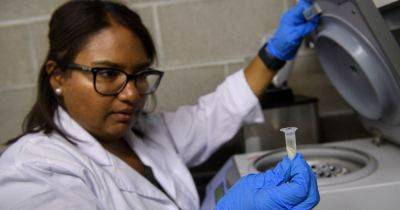Scientists Find About A Quarter Million Nanoplastic Particles In Bottled Water
The average liter of bottled water has nearly a quarter million invisible pieces of ever so tiny nanoplastics, detected and categorized for the first time by a microscope using dual lasers.
Scientists long figured there were lots of these microscopic plastic pieces, but until researchers at Columbia and Rutgers universities did their calculations they never knew how many or what kind. Looking at five samples each of three common bottled water brands, researchers found particle levels ranged from 110,000 to 400,000 per liter, averaging at around 240,000 according to a study in Monday’s Proceedings of the National Academy of Sciences.
These are particles that are less than a micron in size. There are 25,400 microns — also called micrometers because it is a millionth of a meter — in an inch. A human hair is about 83 microns wide.
Previous studies have looked at slightly bigger microplastics that range from the visible 5 millimeters, less than a quarter of an inch, to one micron. About 10 to 100 times more nanoplastics than microplastics were discovered in bottled water, the study found.
Much of the plastic seems to be coming from the bottle itself and the reverse osmosis membrane filter used to keep out other contaminants, said study lead author Naixin Qian, a Columbia physical chemist. She wouldn’t reveal the three brands because researchers want more samples before they single out a brand and want to study more brands. Still, she said they were common and bought at a WalMart.
Researchers still can’t answer the big question: Are those nanoplastic pieces harmful to health?
“That’s currently under review. We don’t know if it’s dangerous or how dangerous,” said study co-author Phoebe Stapleton, a toxicologist at Rutgers. “We







